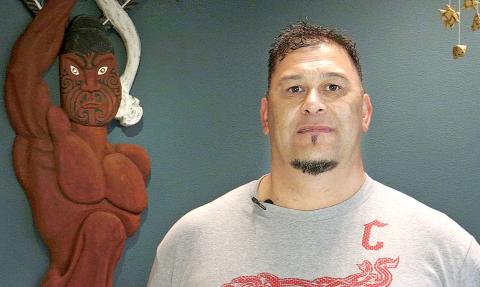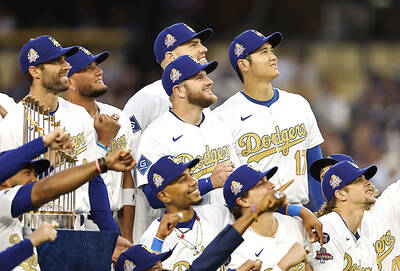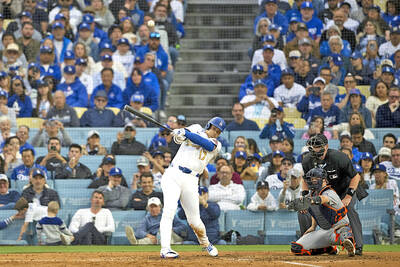The haka is best known to rugby union fans as the spectacular pre-match challenge issued by the All Blacks, but it is primarily a revered cultural tradition among New Zealand’s Maori, who resent it being mocked or exploited for profit.
The All Blacks have performed the ritual since 1905 and is now firmly entrenched as part of the sporting theater that surrounds New Zealand’s matches.
It is no novelty act for Maori, though, with New Zealand’s Maori Development Minister Te Ururoa Flavell describing it as “a part of our culture and identity.”

Photo: AFP
“We use haka to express ourselves in many different settings,” he told reporters. “That includes welcoming guests, saying goodbye to our dead, celebrating success [and] showing our pride.”
Small wonder then, that Maori bristle when advertising executives use their esteemed custom as a punchline in commercials and marketing campaigns.
In recent years, haka parodies have been used to sell everything from British menswear to Japanese soft drinks — all without permission and without a cent being paid to the haka’s traditional owners.
“It’s a feeling of disappointment that people don’t understand what it’s about,” Kahu Ropata, a cultural adviser with the Ngati Toa iwi told reporters.
Maori are divided into regional groups called iwi.
“Using it for profit, that’s not what the haka was intended for. It should be treated respectfully,” Ropata said.
Numerous versions of the haka exist, but the All Blacks only perform two — the traditional Ka Mate and Kapa o Pango, which was introduced in 2005 and can include a throat-slitting gesture.
Ka Mate is Ngati Toa’s haka, composed by the warrior chief Te Rauparaha in about 1820 to celebrate his escape from a rival group’s pursuing war party.
“The essence of the haka is about life [triumphing] over death, the little guy beating the big guy and punching above his weight,” Ropata said.
Over the years, Ka Mate has evolved into New Zealand’s haka, with Ropata saying: “It’s reverberated around the [World War I and II] battlegrounds of Chunuk Bair and Gallipoli and El Alamein.”
Ngati Toa are still regarded as Ka Mate’s custodians, a situation Flavell said the government recognized last year when it passed a law requiring the iwi to be acknowledged when the haka was used.
The iwi also have an agreement with New Zealand Rugby about using the haka and last month hosted All Blacks players at their meeting house near Wellington before the players departed for the World Cup.
However, such laws and agreements have no force beyond New Zealand and Ropata said his people were reliant on overseas companies doing the right thing, inviting them to consult the iwi before using the haka.
“For Ngati Toa, there’s no room for disrespecting the haka,” he said. “So the word to the marketing companies is that if they are to use it, use it appropriately.”
While commercial exploitation of the haka might rankle, Ropata said Ngati Toa took immense pride in seeking the Ka Mate haka performed on the world stage by the All Blacks.
His tribe’s Ka Mate was the only haka performed by Richie McCaw’s men in the pool stages of this tournament, with Kapa o Pango making its first appearance ahead of the quarter-final win over France.
France have a history of confronting the Maori challenge.
“To stand there eyeball to eyeball, I think that’s the whole way of approaching it,” Ropata said. “It shows your opposition, in this case the All Blacks, that you’re ready to go into battle on the field.”
In 2007, the French wore red, white and blue shirts to form a giant tricolour, staring down the New Zealand players before scoring a famous 20-18 quarter-final victory in Cardiff.
Four years later, before the 2011 final, they formed a flying-V and marched into the All Blacks’ half, falling just short of a another stunning upset before New Zealand prevailed 8-7.
“It’s saying that this is our land, our whenua [territory], our field and we’re here to play,” Ropata said.

Shohei Ohtani and Clayton Kershaw on Friday joined their Los Angeles Dodgers teammates in sticking their fists out to show off their glittering World Series rings at a ceremony. “There’s just a lot of excitement, probably more than I can ever recall with the Dodger fan base and our players,” manager Dave Roberts said before Los Angeles rallied to beat the Detroit Tigers 8-5 in 10 innings. “What a way to cap off the first two days of celebrations,” Roberts said afterward. “By far the best opening week I’ve ever experienced. I just couldn’t have scripted it any better.” A choir in the

After fleeing Sudan when civil war erupted, Al-Hilal captain Mohamed Abdelrahman and his teammates have defied the odds to reach the CAF Champions League quarter-finals. They are today to face title-holders Al-Ahly of Egypt in Cairo, with the return match in the Mauritanian capital, Nouakchott, on Tuesday next week. Al-Hilal and biggest domestic rivals Al-Merrikh relocated to Mauritania after a power struggle broke out in April 2023 between the Sudanese army and a paramilitary force. The civil war has claimed tens of thousands of lives and displaced more than 12 million people, according to the UN. The Democratic Republic of the Congo-born Al-Hilal

The famously raucous Hong Kong Sevens are to start today in a big test for a shiny new stadium at the heart of a major US$3.85 billion sports park in the territory. Officials are keeping their fingers crossed that the premier event in Hong Kong’s sporting and social calendar goes off without a hitch at the 50,000-seat Kai Tak Stadium. They hope to entice major European soccer teams to visit in the next few months, with reports in December last year saying that Liverpool were in talks about a pre-season tour. Coldplay are to perform there next month, all part of Hong Kong’s

Shohei Ohtani, Teoscar Hernandez and Tommy Edman on Thursday smashed home runs to give the reigning World Series champions the Los Angeles Dodgers a 5-4 victory over Detroit on the MLB’s opening day in the US. The Dodgers, who won two season-opening games in Tokyo last week, raised their championship banner on a day when 28 clubs launched the season in the US. Dodgers manager Dave Roberts shuffled his batting lineup with all four leadoff hitters finally healthy as Ohtani was followed by Mookie Betts, then Hernandez and Freddie Freeman in the cleanup spot, switching places with Hernandez. “There’s a Teoscar tax to